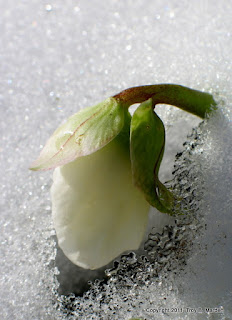It’s hard to believe that Thanksgiving has already passed and December 1 is bearing down upon us. And of course, the weather has taken a turn for the worse long before I (or the garden) was ready. In fact, I’m sitting here writing to you now with a fire in the fireplace and snow–yes, SNOW!–bearing down on west Tennessee. It remains to be seen whether it will make it all the way to the Nashville area, but indications are that we’ll have at least a dusting and maybe as much as inch or so before it’s said and done. Some areas are expecting more!
Even with the weather turning sour, the garden still has some life in it. In fact, this beautiful “Christmas rose”, Helleborus niger ‘Josef Lemper’ just started flowering this week and will continue, completely unfazed by the weather, until April! It is my favorite of all of the recent hellebore introductions. There are others, as well, but none that have the flower power of Josef.
 |
Here is Josef Lemper last January with a bud pushing up through the snow!
Other winter favorites include the many witchhazels like Hamamelis ‘Primavera’, pictured below. Flowering as early as January in warmer climates, its bright yellow petals are a bright spot in the winter garden and are completely unaffected by cold temperatures.
A plant that often gets a bad rap for being “invasive”–another topic for another blog post–is Mahonia bealei, Leatherleaf Mahonia. Its outstanding architectural form is a welcome presence year-round in the garden, but my favorite feature of mahonia is its winter blooms. In fact, its one of the few nectar sources available to honeybees that emerge to scavenge for food on warm winter days.
One last winter favorite, and yes, another of those that some gardeners consider “invasive” (remove the seedheads and they won’t move an inch, and it’s not that time consuming–you deadhead everything else…) Arum italicum is an important denizen of my winter garden. The foliage emerges in late October and early November, remaining completely evergreen throughout the winter, thumbing its nose at temperatures well below freezing. If we dip down into the teens for an extended period, some leaves my suffer some frost damage, but those can simply be removed and with the warm days of spring, new foliage will appear. Keep in mind that this is a plant that goes dormant in the summer, hiding underground during the hottest months of the year, so plan accordingly. Its the perfect plant to mix in with hostas and other shade lovers that are dormant in winter. The arum will be up all winter long and as it goes dormant in early summer, the hostas will take its place. In autumn, the cycle will start over as the hostas go dormant and the arum emerges.
So just because winter is knocking at the door doesn’t mean I have to let it in, and even on the coldest winter days the garden will remind me that spring will–eventually–return.






